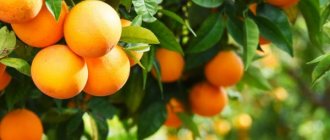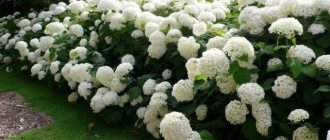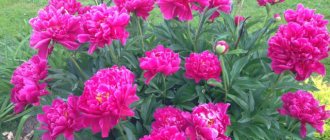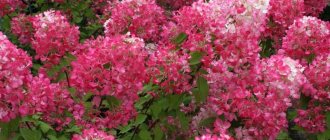The Platycodon bell certainly attracts attention. Its buds look like swollen bright balloons, and its flowers look like bells with five petals, and the autumn leaves acquire yellow-purple shades until frost. This perennial plant with beautiful flowers that look like colorful lanterns is suitable for growing in the garden or can live on your windowsill. Well-lit places are best suited for Platycodon, because in natural conditions it can be found on the edges of forests, clearings, and on the rocky slopes of Eastern Siberia. Without transplantation, a flower can grow in one place for up to 5 years.
Origin of the name and place of distribution
The broadbell received its name due to the appearance of the flowers, which really look like large bells. It is known that naming comes from the ancient Greek language. The only representative of the genus is called Platycodon grandiflorus, or large-flowered bellflower, sometimes confused with broadleaf bellflower, which, of course, cannot be done, since these are completely different plants.
The bushes grow in China, Korea and Japan, and are sometimes found in the Far East and Eastern Siberia. Platycodon has been cultivated since 1872, but the peak of the plant's popularity occurred at the beginning of the 20th century.
Description
Platycodon grandiflora has a well-developed root system, the shoots of the flower are quite tall, they are abundantly covered with leaves. The height of the stems varies from 20 to 80 cm. In the lower part the foliage is collected in a rosette. Platycodon greenery is characterized by a bluish tint. The inflorescences consist of several wide flowers, the number of which can reach 5 pieces. If you look closely at the petals, you can see pronounced veins.
The wide-open flowers are about 8 cm in diameter in many varieties, including the white-flowered Platycodon grandiflora Aster. Plants with blue petals have thin dark mesh veins. Some forms are dark purple in color. The buds are shaped like bells and lanterns. Flowering begins in mid-July and lasts 2 months. According to reviews from gardeners, platycodon goes well with crops such as gypsophila, low-growing phlox and tall bell.
Varieties
There are several varieties of the plant. The color of the petals directly depends on the variety of Platycodon and varies from pink and white to pale blue. Sometimes dark veins appear on the flowers. All varieties are similar in appearance, but have slight differences in the type of petals and their color, the size of the bush and bells.
If we talk about flowers of the Astra type, we can select Platycodon grandiflora Astra Pink. Its petals are painted in a delicate pink shade. Platycodon Astra Blue is characterized by blue flowers. There are varieties with white petals. The peculiarity of the Astra type plant is that its bushes are low-growing. The Double variety is very popular. These flowers have petals arranged in two rows. The veins are best expressed in the plant variety Platycodon Pink Florist. The bloody veins are clearly visible against the soft pink background. The large-flowered Platycodon Fuji Blue, on the contrary, has only one row of petals, and the color of the flowers is very delicate. There are several more varieties of crops with which you can decorate your site.
- Album. The shoots of this variety grow up to 60-80 cm, white flowers reach 8 cm in diameter. There are blue veins on the surface of the petals. According to reviews, flowering lasts for quite a long time: from June to August.
- Shelp Pink is a plant 80 cm high. Large flowers are light pink in color.
- Marisil Blue is a low bush whose shoots grow up to 35 cm. The blue petals have a lavender tint.
- Fairy Snow is another variety of tall Platycodon. The length of the shoots reaches 80 cm. According to reviews, delicate single flowers look very impressive; they can be painted white or light lilac.
- Epoema is the shortest variety of broadbell, the height of which does not exceed 20 cm. The flowers are colored blue-violet. Experienced gardeners advise growing the crop in rock gardens and rock gardens.
- Snowflakes is a bush that reaches a height of only half a meter. The flowers are semi-double, white, and attract attention.
- Mather of Pearl. The shoots grow up to 60 cm. There are pale pink flowers on the stems.
There is a flower called Codonopsis Ussuri, which is very similar to Platycodon, moreover, it is closely related to the broadbell. However, codonopsis flowers have a strong aroma that some people may find unpleasant. For this reason, it is not very popular among domestic gardeners.
Broadbell platycodon grandiflora
Thanks to its roots, the plant easily adapts to different soil conditions. Tall shoots can reach a height of 100 cm. Neat leaves below form a rosette, and up to 5 large flowers can appear in inflorescences. The petals are quite thick, so the flowering period is long - about 2 months.
Platycodon wakes up in the spring about two weeks later than other perennial plants. On average, Platycodon blooms from June to August with large flowers, the size of which can reach 8 cm. The stems and buds of Platycodon are poisonous, but they coexist well with other plants. Next to the broadbells you can plant phloxes, peonies, geraniums, wormwood, irises, and be careful with dipladenia
The plant is a bush with foliage. The leaves of most Platycodon are oblong, with a smooth edge, but there are plants with small jagged edges. The main decoration of the plant is flowers.
Most varieties bloom in mid-June. Flowers in the axils at the tops bloom, showing inflorescences of 2-5 buds. The peduncle is quite flexible, so under the influence of gravity the buds bend down. Most often, the corolla consists of five petals, but in some varieties they are arranged in many tiers. These are double and semi-double types of broadbells. When flowering, up to ten shoots can appear on one adult plant.
Platycodons bloom only for 2-3 years, when the rhizome has gained sufficient mass. But in late autumn the plants acquire brightly colored leaves. Its lemon and then yellow-red leaves last until frost, decorating the garden. After flowering is complete, the seeds ripen in the seed capsules. They fully ripen in September-October.
Landing
The plant is usually planted in open ground at the end of spring, when the temperature at night no longer drops to about. According to reviews, you need to take care of comfortable conditions for culture on the site. It should be well lit, although in some cases the crop can be planted in partial shade. Loose soil that contains the necessary set of nutrients is suitable for growing platycodon. The soil should be drained first. Use loam with added sand as a substrate; the acidity should be neutral. Gardeners give this advice in their reviews.
Please note that the roots of Platycodon grandiflora grow not horizontally, but vertically. For this reason, it is better to plant the crop in areas where there is no groundwater. Since the rhizome is tender, it is not customary to replant the plant, which means that the bushes stay in one place for 10 years or longer.
Before planting flowers in open ground, dig up the soil and add fertilizer to it. You will need a tablespoon of complex mineral fertilizer, as well as half a glass of tree ash. The size of the hole should be slightly larger than the dimensions of the pots with seedlings. The distance between the holes should be 30 centimeters or more. Gardeners advise pre-watering the soil, after which you can place the crop in the holes and completely cover them with soil.
Planting on an area of an adult plant
At the end of summer you can buy an adult platycodon bush. If you purchased the plant before mid-August, it is better to plant it in a prepared place. It is imperative to provide the flower with sufficient watering.
If the bush was purchased in the fall, you will have to postpone planting until next spring. To keep the flower healthy until this time, you need to treat the plant in the pot as if it had already been planted. To do this, dig the pot into the ground, and in the fall, cut off the stems and securely cover the plant. Make sure that there is no excess moisture; to do this, plant in an elevated area.
Watering
Within 15 days after planting the crop in open ground, the plants must be watered daily, according to reviews from gardeners. After this period, this procedure is carried out as necessary. As an adult, Platycodon grandiflora can tolerate heat and dryness. During watering, you need to loosen the soil and get rid of weeds. If the place where the crop grows is covered with mulch, then the above procedures can not be carried out too often.
Possible problems
Platycodons are disease resistant. The greatest danger for them is excessive watering, which causes rot. When affected areas are detected, simple measures are often sufficient: reducing watering, loosening the soil. Damaged parts of the plant are removed during transplantation. An emergency measure may be a transplant. If rot continues to spread despite the measures taken, then it is necessary to use fungicides for disinfection.
It is not for nothing that flowers are used in oriental cooking. Their taste attracts various rodents. To expel mice and moles from the area, you can use various rattles and fill the holes with water. If platycodon requires replanting, it is best to do it in winter, when the plant is dormant.
Platycodon is easily pollinated. Therefore, if you independently prepare seeds for further planting, you must carefully place other plants nearby to avoid losing the characteristics of the variety in the future.
Where can you use a bell?
In landscape design, plants can be used for various purposes. They allow you to make bright accent spots in clearings and lawns, in flower beds. Bluebells are often used as partners for roses and other plants. Flowers look great in compositions that involve continuous flowering. Plants can not only be used in combination with other types of flowers, but also used alone. Platycodon are also used in bouquets.
Toraj-namul
The prepared root, from which the bitterness has been removed, is cut into strips. To it add a little finely chopped green onion, garlic and half a spoon of ginger, sesame oil. The mixture is fried in a frying pan, 100 ml of water is added and simmered until completely evaporated. After this, add a little more sesame oil and salt, and the salad is ready.
Currently reading:
- How to grow Chinese cabbage in open ground
- Planting to decorate the site with three types of coniferous trees
- Choosing cucumbers for open ground according to your preferences
- Exquisite juncus (rumen) spiral-shaped in the interior
Share the news on social networks
About the author: Lyudmila Vasilievna Nosikova
Agronomist of the state agricultural enterprise "Garovskoe" of the Khabarovsk region of the Khabarovsk Territory.
Growing from seeds
Platycodon grandiflora Astra, as well as other varieties of this crop, can be propagated in several ways. The most reliable of them, according to gardeners, is seed. In early or mid-spring, material is sown into the soil for flowering plants. The soil mixture is prepared from sand, peat soil and humus. Sowing is done to a depth of 3-4 mm. It is recommended to keep the crops at room temperature. After 15-20 days, shoots will appear, after which the temperature is gradually reduced to 16 degrees. The seedlings are kept in such conditions before planting in open ground.
Diseases and pests
Platycodon grandiflora flowers are characterized by increased resistance to disease, which summer residents note in their reviews. Most often, the plant is affected by rot, the appearance of which is facilitated by excess moisture. If you find rotting, loosen the soil and reduce watering. In case of severe rot, the flowers are removed and the area is treated twice with a fungicide.
The appearance of moles and mice in the area where platycodons grow is very dangerous. The pests are literally smoked out by blowing smoke into their burrows. You can leave some poisoned cereal on the ground to get rid of mice. It is not customary to use poisons against moles. Rattles are hung throughout the area that make noise when the wind gusts. Experienced gardeners note that moles avoid places where marigolds, daffodils, onions, spurge and garlic grow. In addition, to prevent pests from attacking your area, you need to monitor the humidity level. Moles do not dig in soil that is too wet and do not live in areas where there are an abundance of insects.
Care
Resistant and unpretentious platycodons survive the Central Russian cold well. They calmly survive winters in the Moscow region and Leningrad regions, but freeze out in the absence of snow. To prevent the death of bushes when there is no snow, they must be mulched for the winter after pruning. Dry leaves and other available materials are excellent as mulch. You should not remove dead leaves and stems in the fall; it is better to do this in the spring when removing the cover.
Plants benefit from moderate watering, which can be increased during bud formation and flowering. It is important to remember that Platycodon tolerates drought better than flooding, so if there is heavy rainfall, watering can be temporarily suspended.
Regular fertilizing is beneficial for plant growth and beautiful flowering, but is not necessary. When using natural organic mulch (compost, humus or others), you can refrain from using fertilizers. If necessary, mineral fertilizers are applied from May to July once a month.
To stimulate the formation of new buds, faded flowers must be removed. To prevent the plant from stretching upward too much, you can pinch it a little. If the plant has become overly elongated and lost its stability, tying it up will support it.
Often, in the 3-4th year of life, the plant grows taller than indicated in the description. To stop growth, you can treat the flowers with an inhibitor in the spring. This will slightly slow down the growth of bushes that have just begun to develop. To stop growth, the drug "Athlet", which is widely available in garden centers, has proven itself to be excellent.
Broadbells can grow in an apartment like ordinary indoor plants. They look great in pots, and caring for them is practically no different from caring for outdoor flowers. In order for flowers to please all year round, it is necessary to place the pots in a cool place and ensure good drainage. Watering indoor platycodon should be a little more often in the hot season, and in winter it is better to reduce it. For comfortable growth, the flower will need a lot of diffused light.











